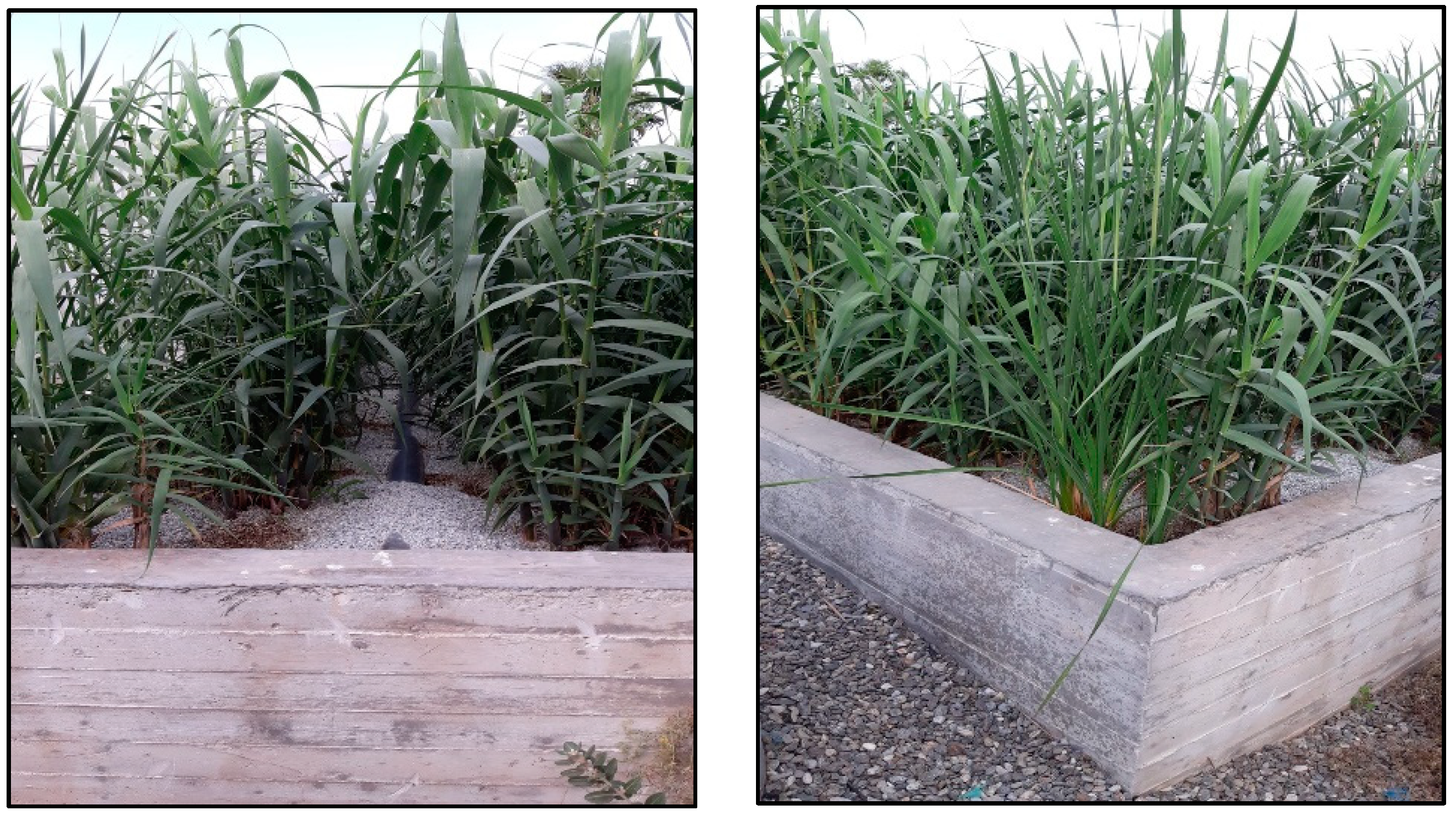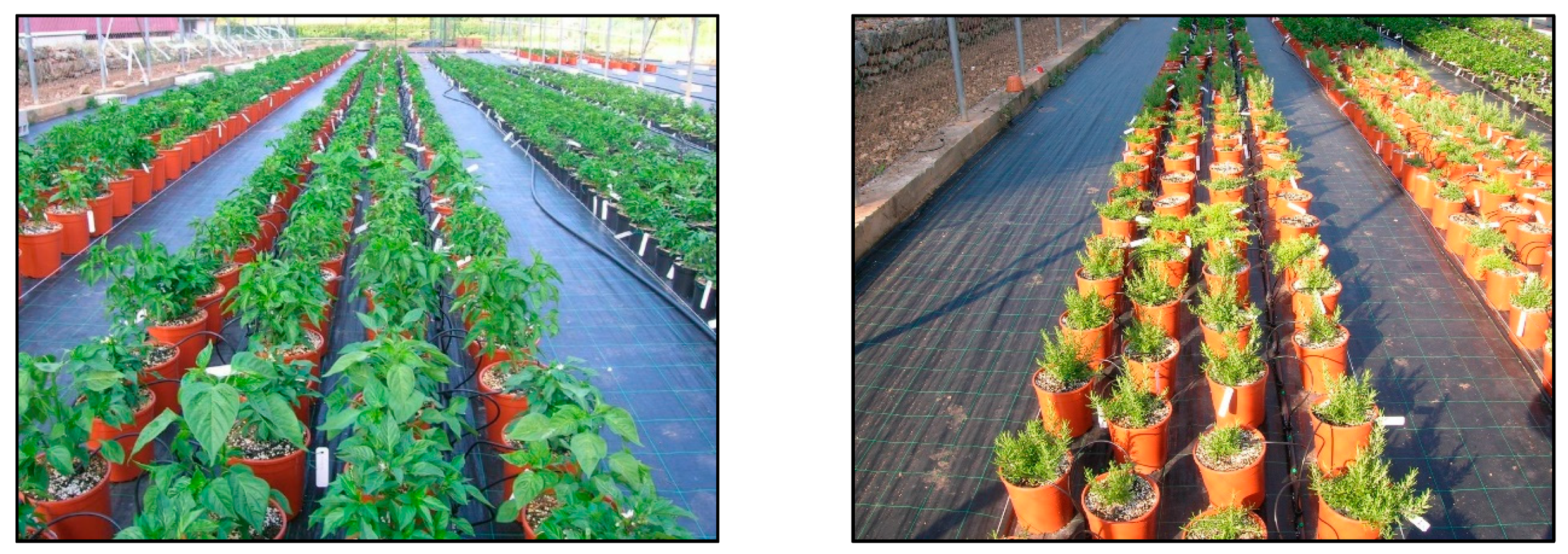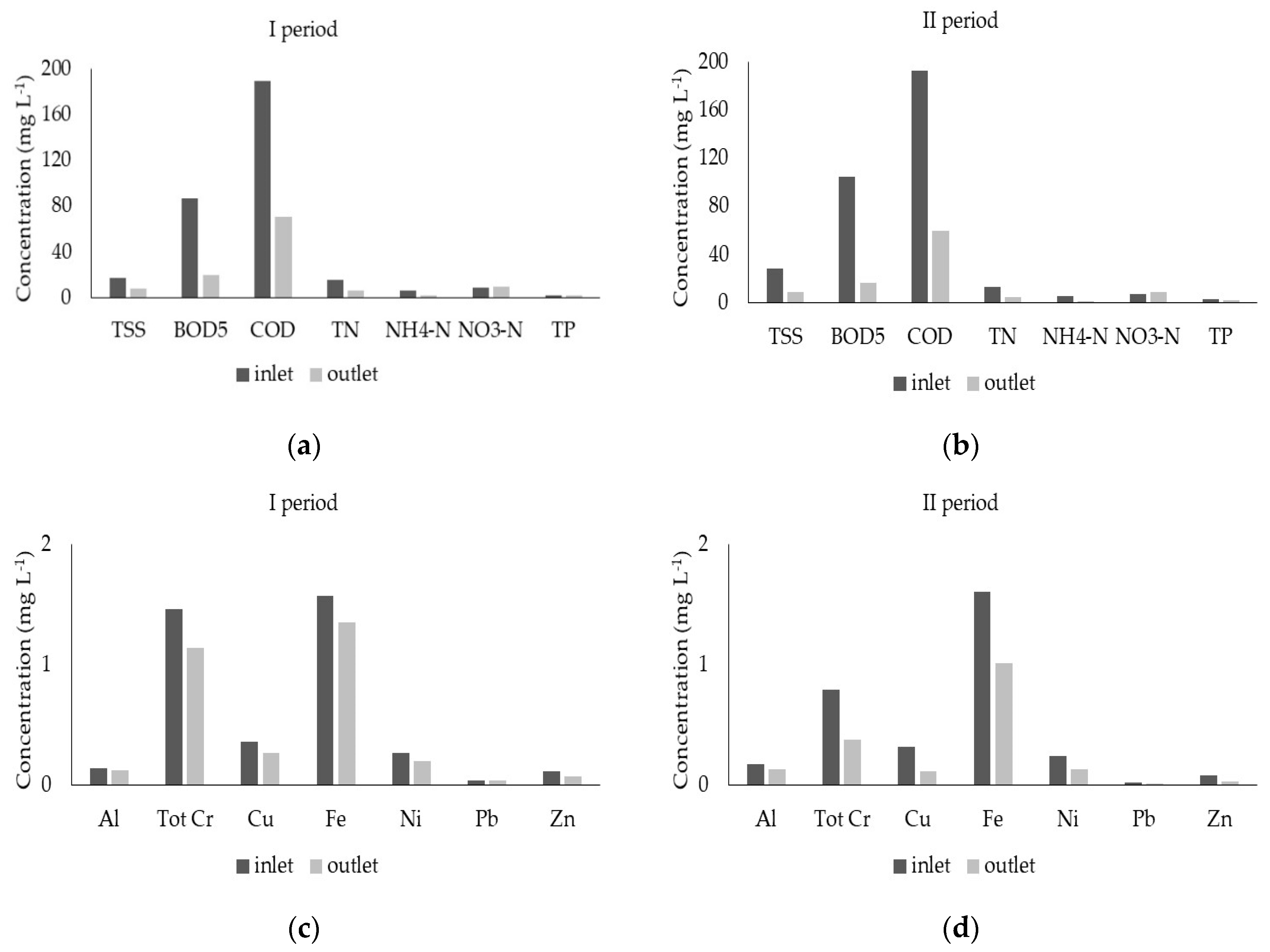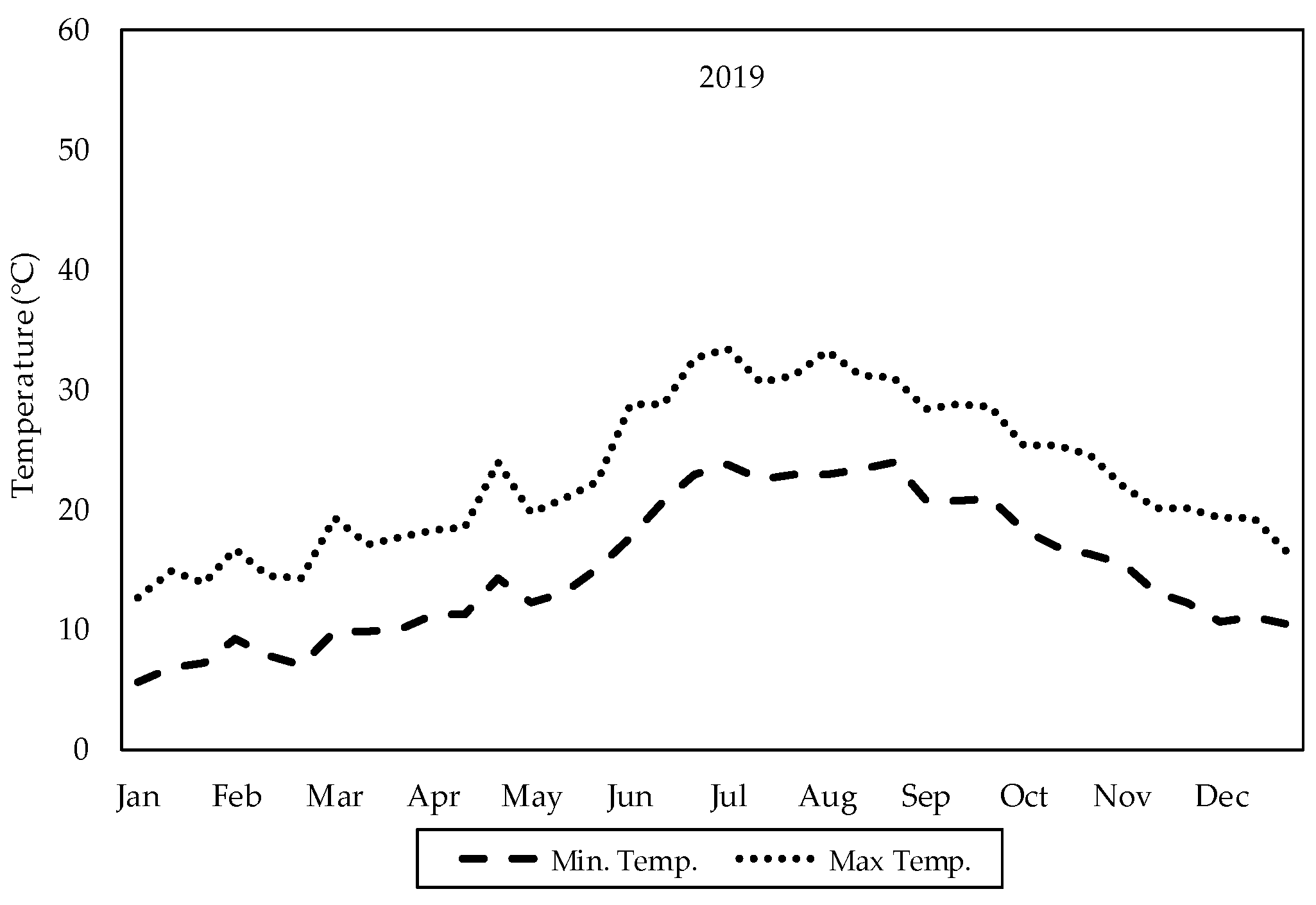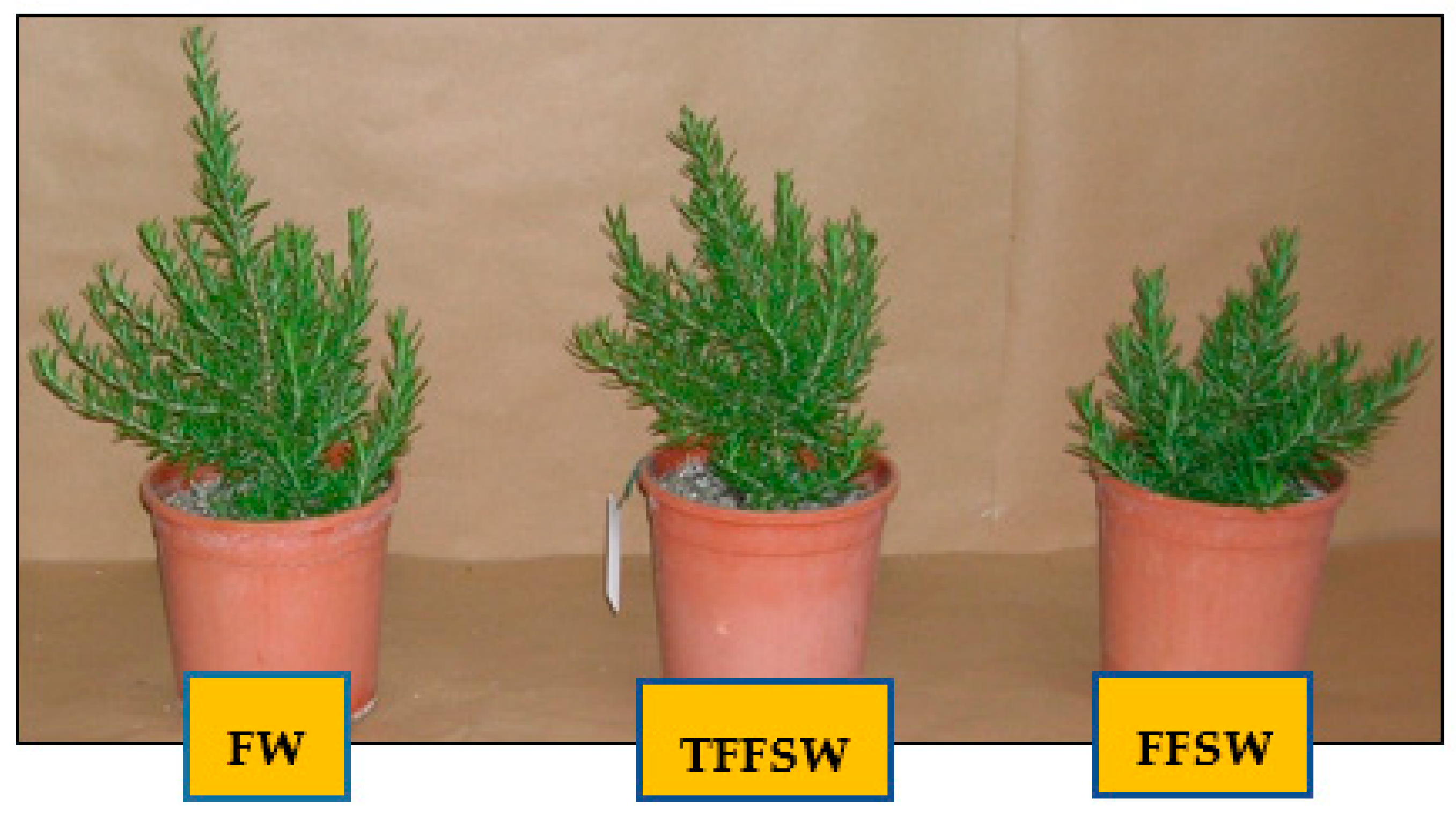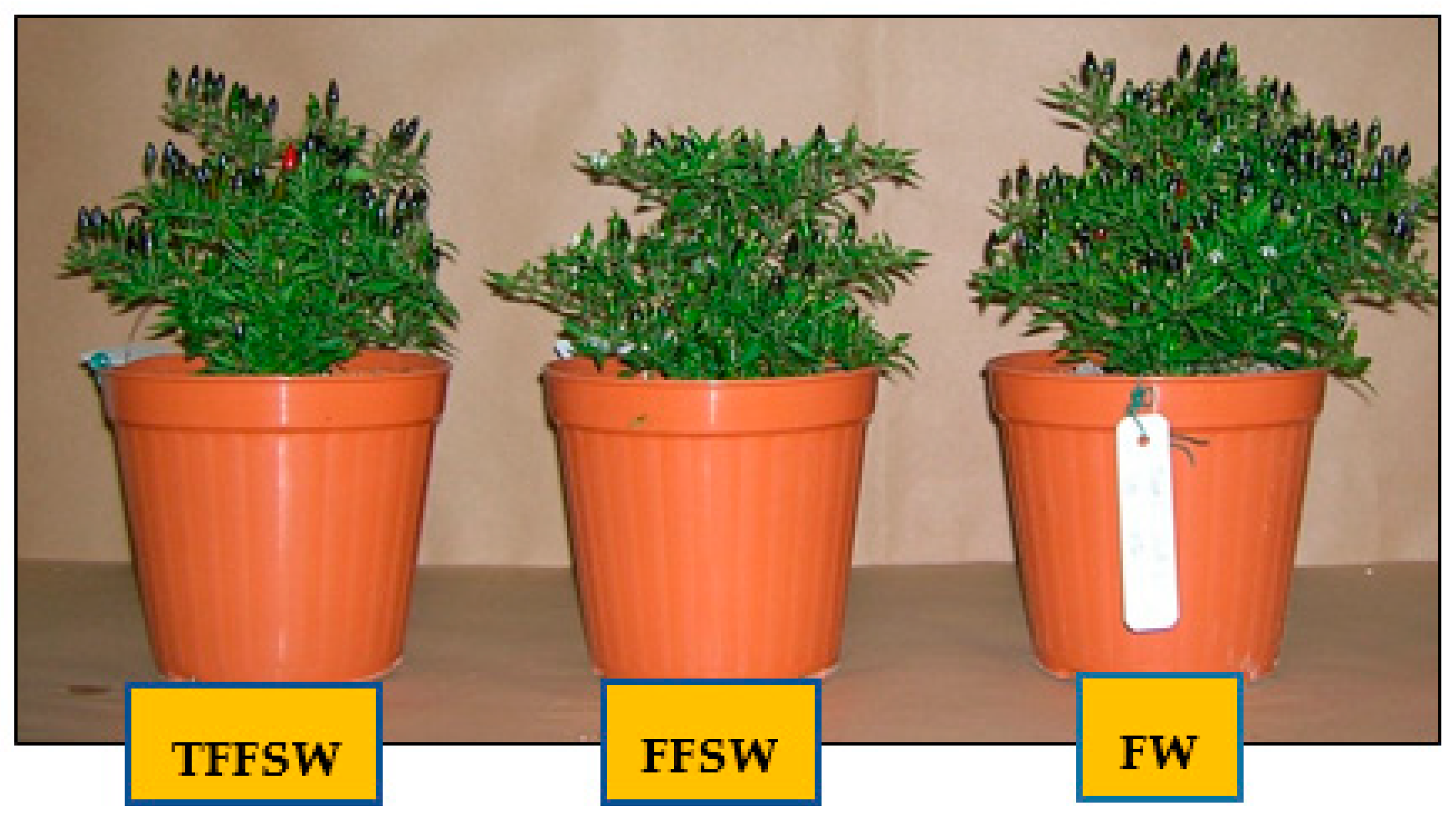3.2. Removal Efficiency of Pollutants in the VSSFs CW
Data showing chemical-physical variations relating to FFSW are shown in
Table 1.
The pH value at the inlet of the VSSFs CW was moderately alkaline; however, at the outlet it was less alkaline, in accordance with other studies [
34,
48]. The decrease in the pH value has been previously explained [
49] by the production of CO
2 caused by the decomposition of plant residues in the substrate, by the removal of various wastewater components retained in the root area and by the nitrification of ammonia nitrogen. In our study, the FFSW average temperature at the inflow was 21.86 °C but it decreased through the system. The decrease in temperature at the outlet of the VSSFs CW was probably due to the fact that the system operated for most of the day under shady conditions. The EC variation was different in the two monitoring periods and it was higher (14.25%) in period II due to the better climate conditions for plant growth. As reported by Kadlec et al. [
44], despite the fact that the evapotranspiration process increased the solute concentration, the decrease in the EC value could be due to various factors, such as nutrients uptake by plants and microorganisms, and the adsorption by the roots, substrate and undecomposed plant residues. An increase in the DO value was found at the outlet of the system for both periods; the greater atmospheric aeration of the VSSFs determined a higher oxygen content in the CW that was exploited by aerobic bacteria to remove the organic and mineral pollutants of the FFSW.
At the inlet of the CW unit, pretreated FFSW pollutant concentrations were lower than prior to pretreatment. Intensive pretreatment (degreasing and settling), in fact, provided efficient treatment of the FFSW through physical, chemical and biological processes.
Average TSS RE was consistent with values found in the literature for VSSFs [
8,
50,
51] and can be described mainly by physical processes such as filtration and sedimentation in the substrate and plant roots, followed by aerobic and anaerobic microbial degradation inside the substrate [
51,
52]. Comparing the two periods of study, average TSS RE was different in period I compared to II and can be explained by plant growth during the year. As the CW unit was planted with two warm-season species, these species showed maximum growth during the spring and summer when air temperatures increased, and above- and belowground biomass values reached peak growth. In period II, from March to July, the matrix formed by the roots of the two species with the substrate trapped TSS and lowered the velocity of water more efficiently than during period I (in which vegetative activity decreased greatly due to lower air temperatures). This concept was well explained by Zurita et al. [
51], who stated also that the presence of more species in a CW unit can increase TSS removal.
In our study, average BOD
5 and COD concentrations in both periods were much lower at the outlet than at the inlet. However, similar to TSS results, average BOD
5 and COD RE was higher during period II. In general, BOD
5 and COD RE stayed within a range consistent with previous CW VSSFs studies using various types of wastewater [
8,
50,
51] and was probably influenced by the root growth of the two macrophytes. In accordance with other authors [
51,
53], the presence of two species provided a more efficient distribution of roots that favored the development of a microbial community around the root system and the substrate particles. Various bacteria, in fact, due to alternate aerobic and anaerobic conditions in the VSSFs, promoted degradation activities and determined a greater reduction in BOD
5 and COD concentrations [
54]. Furthermore, the higher root density increased the retention time of organic dissolved compounds and, consequently, improved BOD
5 and COD RE in the system.
As regards nitrogen, TN RE was higher in period II (66.50%) compared to period I and fell within the removal percentage rates reported for the VSSFs CW in other studies [
23,
25,
51,
55]. Initial NH
4-N concentration was relatively low and ranged between 0.06 and 18.01 mg L
−1 (period I) and 4.15 and 6.81 mg L
−1 (period II). However, it decreased greatly after treatment in both periods and NH
4-N RE was 65.82% in period I and 72.30% in period II. The high NH
4-N RE in the CW unit was the result of the higher rate of ammonium nitrification due to good aerobic conditions in the system. As stated by various authors [
44], in a VSSFs, the major processes responsible for nitrogen removal are, in fact, nitrification/denitrification followed by plant uptake. During the nitrification process, in particular, ammonium N is oxidated to nitrate which is subsequently absorbed by plants or reduced to N gas during the denitrification process [
48]. In our study, these processes occurred in the CW unit and contributed to NH
4-N RE, although plant uptake and the denitrification process led to different nitrate removal rates. When observing, instead, the average NO
3-N concentration in the influent, it was lower than 10 mg L
−1 in both the study periods. However, unlike that found for NH
4-N RE, the NO
3-N concentration slightly increased in the effluent, thus producing negative RE. Our results were in accordance with those of other authors [
50,
51] who found that the VSSFs CW successfully removed ammonium N but limited denitrification occurred. This fact can be explained considering the unfavorable conditions for NO
3-N removal due to high aerobic conditions in the VSSFs CW. As clearly explained by Abdelhakeem et al. [
50], in a constructed wetland, as nitrate is mainly removed throughout the denitrification processes, anaerobic conditions (required for the onset of NO
3 removal) are not fulfilled under the VSSFs CW. Consequently, as confirmed by Vymazal [
25], the VSSFs offers good oxygen conditions for ammonium nitrification but unfavorable conditions for nitrate denitrification.
The data in
Table 2 show low values for initial TP concentration and removal percentages in both the study periods. In particular, RE values ranged between 20.95% (period I) and 32.66% (period II) and were consistent with those found in the literature for many VSSFs [
33,
50,
56]. However, the values of this study were much lower than those found by other authors [
51,
57] who used substrates with different characteristics. In our research, the lower TP RE was mainly due to the physical characteristics of the gravel which was used as a medium. The literature highlights that the removal of phosphorus is highly dependent upon the type of substrate used [
24] and the high Ca, Al and Fe content in the substrate positively influences the TP RE. A number of studies were carried out in various countries in order to assess the effect of the substrate on TP removal in a VSSFs. In a study on the performance of a VSSFs CW under different operational conditions, the authors of [
50] found that vermiculite media (25%) removed significantly higher amounts of TP compared to gravel (14%) due to marked adsorption of P by vermiculite particles. In another study [
57], it was found that a mixture of a river sand and dolomitic limestone led to a TP RE of 45% in a VSSFs. The type of medium and its physical characteristics such as size and adsorption capacity are, thus, fundamental in order to lower TP concentrations in the effluent, independent of the phosphorus uptake by the plant roots.
Trace metals represent a substantial component of FFSW composition. As reported by Kadlec et al. [
44], although some metals, such as chromium, copper, iron and zinc, are required for plant growth in trace quantities, these same metals can be toxic at higher concentrations. Moreover, other metals, such as cadmium and lead, can be toxic at even low concentrations. In our study, the removal efficiencies of trace metals mostly increased during period II but were found to be lower than the RE of other chemical parameters in the study. In general, in both periods, higher concentrations in the influent (>1 mg L
−1) were recorded only for Fe, while Zn and Cu showed higher RE values. It is interesting to note that during period II, the Pb RE value (46.27%) was appreciable, despite this element being present at a lower concentration. Our findings were compared with results from other studies and considerable differences were found. In a study carried out on a wetland constructed in the Sydney catchment, the authors of [
58] found highly variable REs of trace metals from urban stormwater and reported RE values for Cr (67–84%), Cu (56–86%), Pb (44–89%), Zn (33–87%) and Ni (72–76%). In another study, conducted in experimental, temporarily flooded vertical-flow wetland filters treating urban wastewater runoff, a significant reduction in Cu (>95%) was recorded, while the Ni RE by the filter planted with common reed was found to be lower than that of the unplanted filter [
59]. One study [
44] highlighted the fact that the processes involved in trace metal removal in CWs are various and mainly depend on the vegetation, substrate and water. In particular, vegetation provides several actions, such as metal uptake and translocation, adsorption, organic decomposition and filtration. In our study, the effects of vegetation on trace metal removal were not investigated, however, it is reasonable to sustain that a polyculture system, similar to this study, may result in a higher metal RE than a monoculture system due to the different nutrients uptake potential of the various macrophytes and translocation in plant tissues.
PAHs examined in both periods were in very low concentrations (<0.001 mg L
−1) and RE values were found to be similar in both the periods. The present study did not determine the PAHs concentration in plant tissues, but in the CW unit, the two macrophytes contributed greatly to PAH removal. This statement was confirmed by Ventura et al. [
31], who affirmed that the interaction between plants and microorganisms positively influenced hydrocarbon degradation and improved the quality of wastewater in the effluent. However, although a number of studies [
31,
60,
61] highlighted that filtration and sedimentation represent the most relevant physical processes for PAH removal in a CW, the role of the macrophytes in removing PAHs is also fundamental, as demonstrated in a recent study [
62] by the high concentrations of hydrocarbons found in above- and belowground biomass of Phragmites and Vetiver plants.
At a microbiological level (
Table 3), Escherichia coli was selected as the main bacterial indicator in FFSW and was used to determine the disinfection efficiency of the VSSFs.
The VSSFs was particularly effective at reducing E. coli during the tests. Concentrations of E. coli in the effluent were always lower than 100 CFU 100 mL
−1 in both periods. Our results agreed with those reported by Ávila et al. [
8], who found a higher reduction in E. coli in a VSSFs treating sewer wastewater and stormwater. The relevant removal efficiency of E. coli can be explained by a combination of physical, chemical and biological processes carried out by the plants, nematodes, virus and bacteria, also illustrated by Brix [
63]. Furthermore, taking into consideration the physical and functional characteristics of the VSSFs, it is important to observe that the higher oxygen concentration in the VSSFs determined unfavorable conditions for E. coli survival, facilitated the production of a greater bacteria biofilm and promoted its removal [
64].
In our research, the average values of the chemical and microbiological parameters of TFFSW at the outflow of the VSSFs CW were not all within the threshold values for Italian Legislative Decree 152/2006 regarding the reuse of TWW for irrigation and the discharge of TWW into soil (
Table 4).
In particular, in both periods, average concentrations of total Cr in the TFFSW were higher than the Italian standard limits for irrigation reuse. Furthermore, average concentrations of E. coli were not always acceptable in legal terms, despite the high removal efficiency by the VSSFs. One study [
44] highlighted that microbially mediated processes of oxidation followed by subsequent precipitation of trace metals are considered the most effective metal removal mechanism in a CW. Furthermore, the use of different retention times in the system can positively affect the removal rate of bacteria due to changes in aerobic/anaerobic conditions in the substrate. The need to adopt these solutions and to improve biological and physical processes is evident in order to increase the removal efficiency in a VSSFs CW.
3.5. Effects of Source of Irrigation Water and Type of Plant Habit on Rosemary Plants
Data regarding the morphological and aesthetic characteristics of rosemary plants, under the influence of source of irrigation water and type of plant habitus, over the 2019 growing season, are shown in
Table 6.
Irrigation water and plant habitus had significant effects on all the parameters in the study. Results revealed also that the interactions between the main factors were significant for all the parameters.
In general, the growth cycle length of the rosemary accessions was found to be close to 120 days on average (data not shown).
When considering the morphological parameters, plant growth was greater in FW- and TFFSW-irrigated plants than in FFSW-irrigated plants. Differences in plant height with respect to the source of irrigation water were significant during the test period. In particular, FW- and TFFSW-irrigated plants were taller than FFSW-irrigated plants, on average (
Figure 8).
When comparing the types of habitus of rosemary plants, it was found that erect plants were significantly taller than prostate plants. All interactions between the two main factors had significant effects on plant height. The highest average values of plant height were obtained at FW-by-erect plant and TFFSW-by-erect plant interactions. On the contrary, the lowest average value of plant height was recorded at the FFSW-by-prostrate plant interaction.
Significant differences in plant diameter were found with respect to both main factors. Plant diameter reached the highest average values in FW- and TFFSW-irrigated plants and in rosemary plants with an erect habit (
Figure 8). Similar to the plant height result, the highest values of plant diameter were recorded at FW-by-erect plant and TFFSW-by-erect plant interactions. The ratio between plant height and diameter was not significantly influenced by the source of irrigation water. In contrast, the two rosemary accessions showed significant differences for this parameter with values which ranged from 0.57 (RSM_2) to 0.72 (RSM_1). The lowest average value of this ratio was observed at the FFSW-by-prostate plant interaction.
Differences in the number of primary and secondary branches per plant were found to be significant with respect to source of irrigation water and plant habitus. In particular, the highest average values for both these morphological parameters were recorded in FW- and TFFSW-irrigated plants compared to FFSW-irrigated plants. Similar to the previous results, the irrigation water-by-plant habitus interaction effect highlights the fact that, at IW1 and IW2, PH1 obtained the highest average values of number of primary and secondary branches per plant compared to other combinations.
The number of leaves per plant was significantly affected by irrigation water and plant habitus and was found to be 11.44, on average, for the two accessions. The maximum number of leaves per plant was recorded for FW- and TFFSW-irrigated plants. However, in contrast with the results of other morphological parameters, rosemary plants with a prostate habit produced the maximum values (13.94), on average, for number of leaves per plant. Furthermore, prostate plants showed the higher values when interacting with the three sources of irrigation water compared to erect plants.
With regard to aesthetic parameters in the study, the two main factors significantly affected the general appearance of the rosemary plants in terms of visual quality. More specifically, FW- and TFFSW-irrigated plants showed higher average scores for visual quality with respect to FFSW-irrigated plants (
Figure 8). Greater variability was observed, instead, between the two rosemary accessions. The plants with an erect habit had, on average, the best visual quality performance (5.17) during the test period. Finally, erect plants exhibited the highest visual quality scores when combined with the three sources of irrigation water.
Our results highlight the fact that FW- and TFFSW-irrigated plants showed greater growth and better general appearance in comparison with FFSW-irrigated plants. This fact could be mainly explained by the different trace metals levels in the three sources of irrigation water in this study. In fact, the higher trace metals levels in FFSW with respect to FW and TFFSW probably produced adverse effects on plant growth and reduced the visual quality of the rosemary plants.
The authors of [
67] reported that trace elements are highly persistent and can interact with roots by adsorption or release from soil particles, increasing the risk of toxic effects on plants. It was demonstrated that heavy metal accumulation in plant tissues can produce significant physiological and biochemical responses in plants and can interfere with metabolic processes, resulting in weak plant growth, chlorosis and biomass yield depression [
68].
In a study on the effects of heavy metals on the morphological characteristics of
Taraxacum officinale Web, the authors [
69] found that the accumulation of high amounts of different metals, such as Cd, Cr, Cu, Fe, Pb and Zn, in both shoots and roots determined significant reductions in leaf thickness and changes in cell structural organization in comparison to plants grown on unpolluted soil. On the contrary, in another study [
70], it was reported that some crops, such as mint, basil, sage, lavender and rosemary, can act as hyper accumulators of heavy metals, bio-monitors and facultative metallophytes. It has been observed that heavy metal stress can enhance their essential oil percentage as well as genetic and environmental factors being able to positively influence secondary metabolite biosynthesis in several aromatic and medicinal plants [
71,
72,
73,
74,
75].
In particular, Parra et al. [
76] stated that rosemary plants can exhibit good tolerance when cultivated in heavy metal-contaminated soil and are able to translocate high heavy metal rates from roots to shoots. However, they found that high trace element concentrations in the soil and tissues of rosemary plants were related to decreases in biomass yields and inhibition of root development. These findings were also confirmed by other authors [
77,
78] who provided a negative correlation between trace element concentrations and plant biomass and root development, highlighting that high trace elements concentration levels could determine a significant reduction in plant growth.
In our study, although irrigation with FFSW produced negative effects on plant growth and general appearance, it is worth noting that TFFSW-irrigated plants were not significantly different from FW-irrigated plants in terms of morphological and aesthetic parameters. This underlines and confirms that the reuse of TWW represents an alternative water source also when irrigating ornamental plants in various sites such as nurseries, parks, open fields and other green areas in urban environments.
A number of studies [
65,
79,
80,
81] have investigated the reuse of TWW on various medicinal and aromatic plants, such as basil, chamomile, mint, oregano and rosemary, in arid and semi-arid regions, focusing generally on the effects of TWW on the essential oil content and anti-oxidant properties of the plants. In particular, in a study on rosemary [
81], it was found that rosemary plants continued to grow well when irrigated with urban TWW over two years and plant canopy diameter increased significantly during the test period. However, when observing the composition of the source of irrigation water used in these studies, it is possible to note an appreciable amount of macro- and micronutrients and a low heavy metal content. It is evident, therefore, that low levels of trace elements in TWW represent a fundamental condition for TWW to be able to produce positive effects on plant growth for rosemary in particular.
3.6. Effects of Source of Irrigation Water and Type of Plant Habit on Ornamental Pepper Plants
Data regarding the morphological, aesthetic and phenological parameters of ornamental pepper plants, under the influence of source of irrigation water and type of plant habitus, over the 2019 growing season, are shown in
Table 7.
All the characteristics tested were significantly affected by irrigation water and plant habitus. Furthermore, the irrigation water-by-plant habitus interaction was significant for each parameter in the study. In particular, FW- and TFFSW-irrigated plants exhibited higher growth than FFSW-irrigated plants during the test period.
Plant height ranged from 32.50 (erect plants) to 14.48 cm (pendant plants), on average. When considering the source of irrigation water, it was found that FW- and TFFSW-irrigated plants were significantly taller than FFSW-irrigated plants (
Figure 9).
Furthermore, regarding the interaction effects between the main factors, the highest average values for plant height were observed in FW-by-erect plant and TFFSW-by-erect plant interactions. On the contrary, the lowest average value of plant height was recorded when the pendant habit factor interacted with each of the three sources of irrigation water.
Plant diameter showed significant differences with respect to the main factors. The highest average values of plant diameter were found in FW- and TFFSW-irrigated plants and in erect plants (
Figure 9). When considering, instead, all the interactions, the FW-by-erect plant and TFFSW-by-erect plant interactions had the highest values of plant diameter.
The ratio between plant height and diameter was significantly affected by the two main factors. More specifically, no significant differences were found between FW- and TFFSW-irrigated plants; in contrast, FFSW-irrigated plants and erects plants exhibited the highest average values. When considering the interaction effects, no significant differences were found for this parameter except for IW1-by-PH2 and IW2-by-PH2 interactions.
The number of fruits per plant was significantly affected by irrigation water and plant habitus and was found to be 407.12, on average, for the two pepper varieties. However, the number of fruits ranged from 662.10 (erect plants) to 152.15 (pendant plants), on average. Similar to the previous results, FW- and TFFSW-irrigated plants obtained maximum values for number of fruits per plant. Furthermore, the erect plants showed higher values when interacting with the three sources of irrigation water compared to pendant plants.
With regard to the general appearance of the ornamental pepper plants, FW- and TFFSW-irrigated plants showed higher average values for visual quality compared to FFSW-irrigated plants. Erect plants had, on average, the best visual quality performance (5.80), while the pendant plants obtained the lowest value (3.67). Erect plants exhibited the highest visual quality scores when combined with FW and TFFSW only.
Finally, irrigation water and plant habitus had a significant effect on ornamental pepper plant phenology. In particular, the number of days between transplanting and beginning of flowering was higher in FW- and TFFSW-irrigated plants (36 days, on average) than in FFSW-irrigated plants. Beginning of fruit development occurred six days later in FW- and TFFSW-irrigated plants than in FFSW-irrigated plants. On the contrary, senescence occurred seven days earlier in FFSW-irrigated plants. In general, FW- and TFFSW-irrigated plants completed their growth cycle within 81 days, whilst the growth cycle length of FFSW-irrigated plants was found to be close to 74 days, on average. It is worth noting that the main phenological stages in the study occurred earlier in erect plants with respect to pendant plants. The significance found for the irrigation water-by-plant habitus interaction instead highlights the fact that, for each source of irrigation water, the differences in the growth stages were consistent with the effects of the main two factors.
Our findings demonstrate that FW- and TFFSW-irrigated plants exhibited higher growth and showed a better general appearance in comparison with FFSW-irrigated plants. Similar to the results of rosemary plants, the different trace metal concentrations in the three sources of irrigation water significantly affected the behavior of ornamental pepper plants during the tests. Hence, the lower trace metal concentrations in FW and TFFSW favored plant growth and improved, in general, the aesthetic characteristics of ornamental pepper plants.
The effects of trace metals, contained in irrigation water, on the morphological and aesthetic characteristics of ornamental pepper have been not investigated in the literature. Due to this fact, it was not possible to compare our findings with those of other studies. Additionally, few studies are available which focus on the use of TWW in ornamental pepper cultivation as affecting growth and fruit quality. In a study carried out in Crete [
66], it was found that TWW application increased plant height and plant biomass compared with FW-irrigated plants of pepper, while the addition of fertigation increased fruit number in both FW- and TWW-irrigated plants, but with a decreasing average fruit weight for TWW application. This was in agreement with previous studies on cucumber and tomato crops when irrigating with FW and TWW [
34,
82]. In another study on the effect of different irrigation levels with different qualities of water on the cultivation of pepper [
83], it was reported that TWW provided nutrients for the plants and determined an increase in plant growth.
In our study, although the chemical and microbiological composition of TFFSW differed greatly from that of FW (
Table 5), TFFSW-irrigated plants were not significantly different from FW-irrigated plants in terms of morphological, aesthetic and phenological parameters. This fact could be explained by considering the agronomic management of pepper plants during the tests. In the FW-irrigated pots, we managed the pepper plants using fertigation during the crop cycle; in the TFFSW-irrigated pots, we exploited the nutrient content in this source of irrigation water to integrate the N, P and K requirements for ornamental pepper. At the outflow of the VSSFs CW unit, the N, P and K average concentrations were found to meet the plant’s requirements. TFFSW was a source of nutrients and, in particular, of N, P and K, therefore its use highlights the fact that TWW irrigation also provides combined fertilization for ornamental pepper plants. It is worth noting that the trace metals and PAH content in the TFFSW was within the threshold values for Italian Legislative Decree 152/2006 regarding the reuse of TWW for irrigation purposes, as well as other chemical and microbiological parameters. These results confirm that TWW irrigation, such as TFFSW, can decrease or even remove the need for mineral fertilization whilst maintaining a high quantitative and qualitative performance of plants. This concept was previously confirmed also for other horticultural crops [
34,
66,
82,
84] and currently should be used by farmers due to the evident economic and environmental benefits with respect to the common management of these crops. In fact, as TWW is an alternative source of water to FW for crop irrigation, it is possible to suppose that the use of TWW of different origin represents a sustainable way to manage the irrigation and fertilization of a number of crops, such as rosemary or ornamental pepper, in areas with prolonged periods of water shortages.
